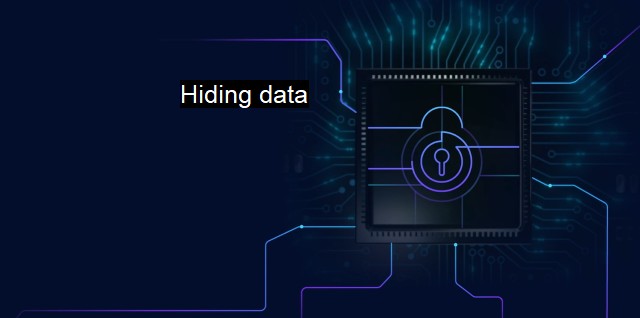What is Hiding data?
Staying Ahead of Cybercriminals: The Importance of Detecting Hidden Data in Cybersecurity
Hiding data, also known as steganography, is a term associated with the practice of concealing information within other information. It is a rapidly developing aspect of cybersecurity and antivirus programs and seeks to ensnare the loopholes in the current standard security protocols.Understanding the concept of hiding data starts with differentiating it from cryptography. While both fall within the security landscape, they serve different purposes. Cryptography is concerned with making the data unreadable, and in contrast, steganography is concerned with keeping the existence of the data, whether encrypted or not, unknown. These two security measures can work hand in hand, meaning smeared data can be encrypted too, thus providing a dual layer of protection.
In the cybersecurity context, steganography becomes a stringent concern because it can serve both purposes. There are nefarious entities among us who might exploit this security approach. They use it to hide malicious codes within ordinary looking files like images, audio, video, and even text and send them across networks, where antivirus programs detect nothing unusual about these files. This reason alone has necessitated the development of advanced security solutions beyond the traditional approaches.
Firstly, for an efficient antivirus program to curtail hidden data, it needs a behavioral-based detection system. Unlike traditional heuristic-based detection systems that relied significantly on the previous known malware signatures, behavioral-based systems aim to identify unusual patterns in file behavior. They monitor seemingly regular scripts for irregularities, and once identified, they can alert the cybersecurity team to carry out the necessary forensics, isolating the hidden data.
Secondly, employing proactive security measures is key, and these steps may necessitate advanced knowledge in steganography techniques, and averting zero-day threats that utilize this approach. Knowledge of such, equips the individuals protecting a network or system on the forms these threats might take, helping them develop measures to combat these forms beforehand. Firewalls, intrusion detection, and prevention systems are few proactive ways to ensure unauthorized entities do not access your network in the first place.
The key to unmasking veiled data lies majorly in effective antivirus software. The structuring of these programs leans towards a combination of both anomaly-based monitoring systems and misuse/signature-based monitoring systems. Although resource-intensive, this approach minimizes instances of hidden data penetration by providing numerous protection layers.
While speaking of steganalysis, the process of detecting hidden data, it is worth noting that the current deep learning algorithms are making impact. They are helping to improve the detection rate, thus eliminating the flaws of traditional methods that relied heavily on extractive techniques, which infamously produce false alarms.
On the global scale, educating individuals and enterprises on the importance of steganography and the dangers of hiding data would significantly curb these security breaches. Prevention, as they say, is better than cure, and in this case, understanding the measures taken by hackers to hide data and building on ways to counteract these steps is indispensable in maintaining a secure cyber ecosystem.
Hence, the complex nature of hiding data has substantiated the need for equally complex security measures, from intricate antivirus systems to conscious user behavior. While its promise can be exploited for wrongful use, steganography equally presents opportunities for cybersecurity professionals. By gaining the necessary skills, one can no longer dismiss steganography as a security afterthought but rather integrate it into the defense strategy. Thus, the essence of understanding what is "hiding data" becomes not solely the knowledge disparity but the application.

Hiding data FAQs
What is data hiding in cybersecurity?
Data hiding is a technique used to protect sensitive information from unauthorized access. It involves masking the data so that it cannot be easily detected or decoded by individuals or software programs. This technique is commonly used to secure confidential information such as passwords, financial details, and personal information.How can I hide my data from antivirus software?
While it is not recommended to hide data from antivirus software, there are some techniques that can be used to do so. One common technique is to use steganography, which involves hiding data within a file or image so that it is not easily detectable. However, it is important to note that attempting to hide data from antivirus software can be illegal and may result in serious consequences.Is data hiding illegal?
No, data hiding is not illegal. In fact, it is a widely-used technique for securing confidential information. However, attempting to hide malicious files or activities from antivirus software can be illegal and may result in serious consequences. It is important to use data hiding techniques ethically and legally.What tools can I use for data hiding?
There are many tools available for data hiding, ranging from simple software programs to advanced techniques such as steganography. Some popular tools include TrueCrypt, VeraCrypt, and Steghide. When choosing a tool, it is important to consider the level of security it provides and whether it is compatible with the system you are using.| | A | | | B | | | C | | | D | | | E | | | F | | | G | | | H | | | I | | | J | | | K | | | L | | | M | |
| | N | | | O | | | P | | | Q | | | R | | | S | | | T | | | U | | | V | | | W | | | X | | | Y | | | Z | |
| | 1 | | | 2 | | | 3 | | | 4 | | | 7 | | | 8 | | |||||||